Contents
Guide

The author and publisher have provided this e-book to you for your personal use only. You may not make this e-book publicly available in any way. Copyright infringement is against the law. If you believe the copy of this e-book you are reading infringes on the authors copyright, please notify the publisher at: us.macmillanusa.com/piracy. Contents INTRODUCTION I would like to step out of my hearts door and be under the great sky. Rilke, Lament I How to account for the Sonnets to Orpheus? Rilke himself regarded them with amazement.
They seem genuinely to have taken him by surprise. Since July of 1921 he had been living in the Chteau de Muzot, a tiny medieval castle-tower near Sierre in the Swiss Valais. There he had been creating conditions hospitable to the resumption of what would eventually be the Duino Elegies, his task since they had been given to him in a burst of inspiration and then broken off, incomplete, almost a decade earlier at Duino Castle on the Adriatic. This meant gradually divesting himself of human contact and conversation, gathering himself into an absolute solitude (one wondrously efficient housekeeper excepted). If he could not will the Elegies to completion, he could at least try to turn himself into a core of undistracted readiness. Meanwhile serendipity was at work, scattering the most diverse influences (at least in retrospect they seem so) into this scene of attempted concentration.
For Christmas 1920, Rilkes lover, the painter Baladine Klossowska (Merline), had given him a French prose version of Ovids Metamorphoses, which prominently features the story of Orpheus. When she departed from Muzot at Rilkes urging in November 1921, she left pinned to the wall opposite his writing table a postcard reproduction of a Renaissance drawing of a youthful, almost carefree Orpheus (though his expression could be anguished) sitting at the base of a tree, singing and playing a stringed instrument, while a gathering of animals (one bird, two deer, and a pair of rabbits) listens attentively. The image would remain in place throughout the winter months of 1922, a token of Merlines absence. Increasingly, Rilke translated. By the end of 1921 he had finished a version of Michelangelos Sonnets, which left him thinking about the strictness of the sonnet form and the extent to which it might be freed. He immersed himself in the work of Paul Valry (by 1921 his most important artistic other), a poet who had remained silent for almost twenty-five years, studying mathematics, and who had only recently resumed writing.
Rilke found in the French poets new work a masculine exactitude and measure that was precisely what he felt missing in things German (and now the pace of every one of his lines is enriched by that deep balanced repose which none of us can muster). At the same time, when he translated Valry he felt an almost bodily sense of fit. In the early winter he agreed, at Valrys request, to translate the latters Eupalinos dialogue into German, and in January he copied out Lme et la danse (The Soul and the Dance), which he would translate in 1926, the last year of his life. The decisive influence came in the form of the record of a young girl approaching death. Rilke knew Vera Ouckama Knoop, the daughter of friends from his prewar Munich days and the playmate of his own daughter Ruth, when she was still a child and already a dancer of great promise. He had learned in 1919 from Veras mother, Gertrud, of her daughters recent death at age nineteen from leukemia, but it was not until November 1921, on the occasion of Ruths engagement, that he chose to write in consolation.
A heartfelt correspondence ensued between these two people who only casually knew each other, and one of Rilkes letters culminated in a wish for some keepsake by which he might remember Vera (some little thing that was dear to Vera, if possible something that she often had with her). The effect on Rilke was overwhelming, and Vera took on an almost hallucinatory reality: Now it is about Vera, he wrote her mother, whose dark, strange, vivid loveliness is so hauntingly unforgettable and so prodigiously evocable that in the very moment of writing this I am afraid to close my eyes, lest I should suddenly, in my own here and now, feel myself completely overwhelmed by it. Orpheus and Eurydice, Rilke and his own dead one, Paula Modersohn Becker, mingle strangely in this awakened vividness. And as Rilke goes on to draw out for Gertrud the significance of her daughters dying testament, phrases appear which he would later employ to articulate the meaning of the Elegies and the Sonnets themselves: How much, how much, how much she was all that, that to which these memorials of her agony bear such deep and irrevocable witness, and (isnt it so?) how wonderful, how unique, how incomparable a human being is! For when everything in her should have been consumed, suddenly there arose in her heart a great flood of light, so much that otherwise it would have sufficed to brighten a long existence here (where?); and in it appeared, so infinitely illumined, the two outermost boundaries of her pure intuition: this, that suffering is an error, a dull misapprehension arising from the physical that drives its wedge, its stony wedge, into the unity between heaven and the earth; and, at the other extreme, the oneness of her wide-open heart with the existing and enduring world, this assent to life, this joyous, impassioned communing to the very last moment with her native earthah, with only the earth? Nay (and this she could not know in these first attacks of breakup and parting)with the Whole, with much more than the earth. Oh, how, how she loved, how she reached out with the antennae of her heart beyond all that that can be grasped or encompassed here He closed by accepting Gertruds pages with an immense obligation to my inmost and gravest self as well as (even if I can only attain it from afar) to my serenity. It would be one obligation, at least, that no one could accuse Rilke of shirking.
II On February 2 the door finally opened. Only a day earlier Rilke had been complaining (again) about the difficulty of concentration, and when he sat down at his appointed time to write, his hope as usual was to coax the Elegies out of hiding. Instead, he began writing sonnets. One followed another, and suddenly Rilke was in the midst of a creative release so extraordinary that he felt himself transcribing, not composing. He wrote continuously, letting the stream of the sonnets gush over me like a deluge, And though the source of the poems was a mystery to him, he understood them as inspired by Vera. He quickly made a hand copy of the entire sequence and sent it to Gertrud on February 7, as an acknowledgment of her daughters role in its creation: Dear, honored friend, In a few thrillingly impassioned days, when I actually intended to take up some other work, these sonnets were given to me.
You will understand with only a glance why you must be the first to possess them. For, elusive as the relationship is (only one sonnet summons Veras own figure into this excitation dedicated to her), it nevertheless governs and moves the course of the whole and penetrated more and morealthough so secretly that I recognized it only graduallythis irresistible creation that so staggered me. If these sonnets were to be published one day, he concluded, there was no question that they would be in memory of Verait was only left for Gertrud to agree on the form the dedication should take. The same day that Rilke sent the sonnets to Gertrud, elegies mirabile dictu! began arriving (My dear friend, he wrote excitedly to his publisher Anton Kippenberg on February 9, I am over the mountain! The Elegies are here!). and Rilke, thrilled with this free-form meditation on Picassos Saltimbanques, substituted it for the poem that had been serving as the Fifth Elegy. Then, with the work that had become Rilkes life-project achieved, something truly unpredictable occurred.


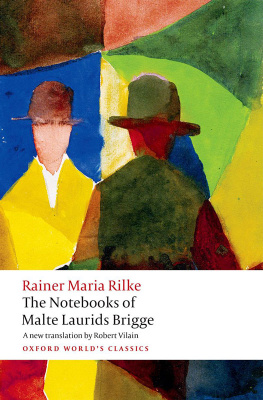
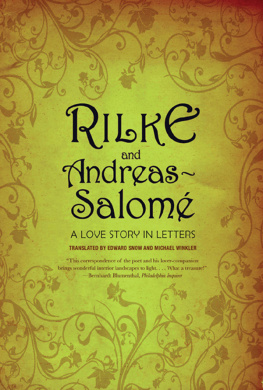
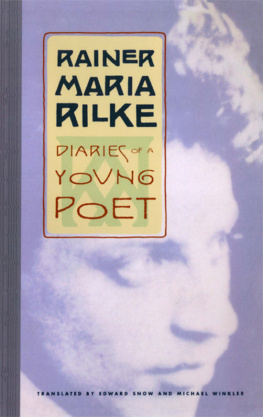


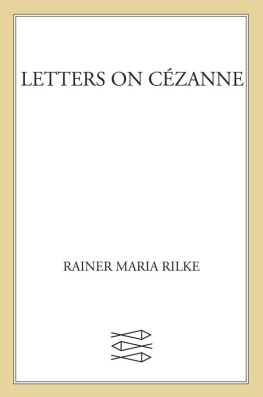
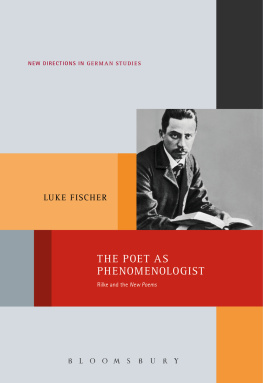
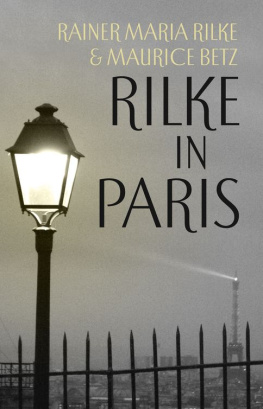
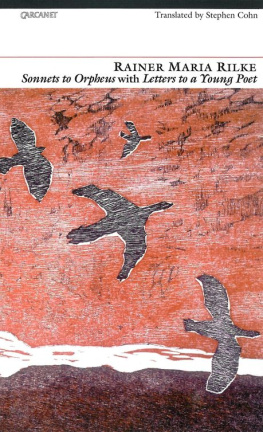
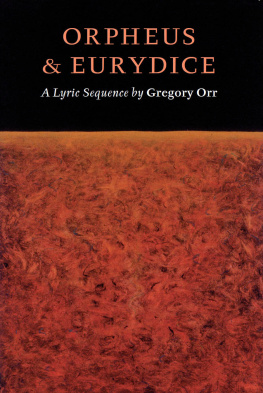
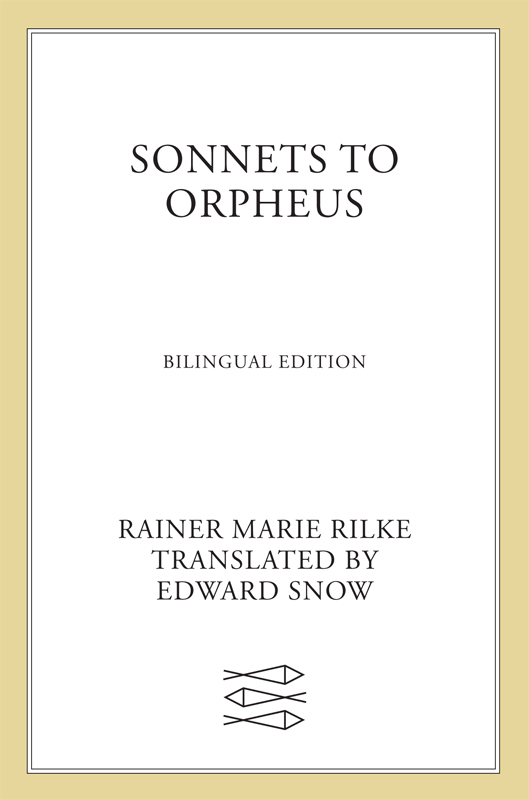
 The author and publisher have provided this e-book to you for your personal use only. You may not make this e-book publicly available in any way. Copyright infringement is against the law. If you believe the copy of this e-book you are reading infringes on the authors copyright, please notify the publisher at: us.macmillanusa.com/piracy. Contents INTRODUCTION I would like to step out of my hearts door and be under the great sky. Rilke, Lament I How to account for the Sonnets to Orpheus? Rilke himself regarded them with amazement.
The author and publisher have provided this e-book to you for your personal use only. You may not make this e-book publicly available in any way. Copyright infringement is against the law. If you believe the copy of this e-book you are reading infringes on the authors copyright, please notify the publisher at: us.macmillanusa.com/piracy. Contents INTRODUCTION I would like to step out of my hearts door and be under the great sky. Rilke, Lament I How to account for the Sonnets to Orpheus? Rilke himself regarded them with amazement.